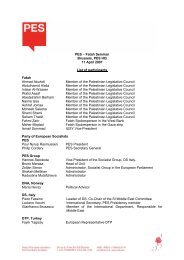Hedge funds and Private Equity - PES
Hedge funds and Private Equity - PES
Hedge funds and Private Equity - PES
Create successful ePaper yourself
Turn your PDF publications into a flip-book with our unique Google optimized e-Paper software.
46<br />
If we assume US mutual fund industry to be around $ 7.000 bn <strong>and</strong> the average management fee<br />
to be 0.60%, the aggregate gross fee income would be (simplifying to the extreme) around<br />
$ 42 bn. In other words, it is not entirely unthinkable that the global hedge <strong>funds</strong> industry is<br />
generating more fees than the much larger US mutual fund industry.<br />
But this is not the total picture.<br />
Some studies estimate that hedge <strong>funds</strong> pay:<br />
4-5 % of AUM to their managers (management fees plus performance)<br />
Around 4 % of AuM to the investment banking industry<br />
To maintain this pay-out <strong>and</strong> keep investors confident <strong>and</strong> satisfied, hedge <strong>funds</strong> need growth<br />
returns of around 20 %!<br />
This fee structure <strong>and</strong> the level is not a “law of nature”. Neither is it market based. It simply seems<br />
to be a “characteristic” of the hedge fund industry <strong>and</strong> not questioned or challenged by anyone.<br />
We think it highly questionable because the pressure of hedge <strong>funds</strong> to create such huge gross<br />
returns is in itself having strong effects on the character <strong>and</strong> concrete content of hedge fund<br />
strategies.<br />
The impact of fees <strong>and</strong> transaction costs to hedge <strong>funds</strong>, investment banks, prime brokers <strong>and</strong><br />
trading counter parties is illustrated in a recent study (Dresdner/Kleinwort. <strong>Equity</strong> research.<br />
February 2007). As seen from the two charts, the “net return to investors” on the right h<strong>and</strong> side<br />
represents the HFR composite index return net of all fees. By adding the 2 % plus 20 % fee<br />
structure, the “gross performance after execution costs” is reached. If we then add the execution<br />
costs, we are having the “gross performance before execution costs”.<br />
A recent paper from Dresdner Kleinwort illustrates this point 11 :<br />
2006<br />
2005<br />
(%)<br />
25<br />
20<br />
15<br />
10<br />
5<br />
<strong>Hedge</strong> fund industry – from gross return to net return<br />
22.5<br />
0<br />
Gross performance Execution cost Gross performance<br />
before execution received by investment after execution cost<br />
cost<br />
banks<br />
Source: Dresdner Kleinwort Equities research estimates<br />
(%)<br />
25<br />
20<br />
15<br />
10<br />
5<br />
17.0<br />
4.3<br />
3.8<br />
18.3 5.3<br />
Fees paid to hedge<br />
fund managers<br />
11 Dresdner Kleinwort, “Credit Suisse, Deutsche Bank, UBS - How important are hedge <strong>funds</strong> for the investment banking industry?”, <strong>Equity</strong><br />
Research 6. February 2007, p.16.<br />
13.1<br />
0<br />
Gross performance Execution cost Gross performance<br />
before execution received by investment after execution cost<br />
cost<br />
banks<br />
Source: Dresdner Kleinwort Equities research estimates<br />
4.3<br />
Fees paid to hedge<br />
fund managers<br />
13.0<br />
Net performance<br />
to investors<br />
18.8<br />
Net performance<br />
to investors




